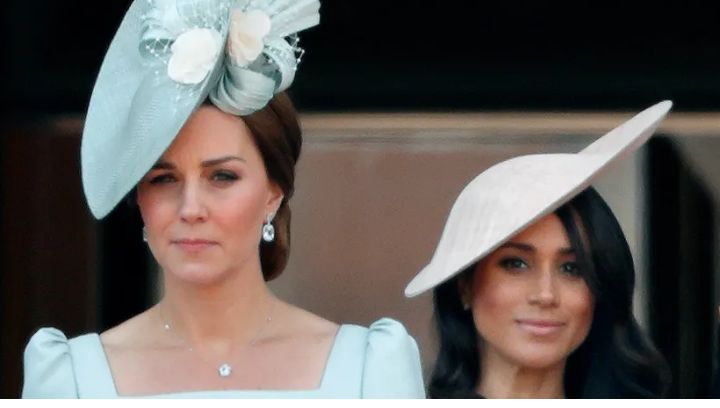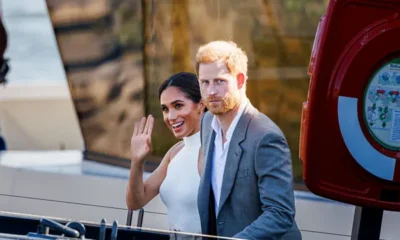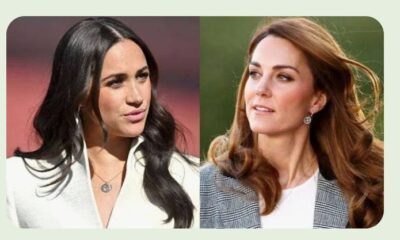CELEBRITY
The story of Kate Middleton’s disappearance is haunted by Meghan Markle

As intrigue mounted last week over a then-missing, now recently appeared Kate Middleton and her Photoshopped picture, British-owned tabloids directed their ire toward a familiar target: Meghan Markle.
To an unpracticed observer, it would be difficult to blame the disappearance of Princess Kate from the public eye on her sister-in-law, but the tabloids are nothing if not resourceful. Page Six reported that Prince Harry and Meghan’s inner circle were mocking Kate’s botched Photoshop and sneering that Meghan would never have made such a mistake. Meanwhile, Meghan and Harry, alleged the Daily Mail, were nothing but a pair of hypocrites. They had used Photoshop on their own pregnancy announcement pictures, and so had no leg to stand on when it came to criticizing Kensington Palace for Photoshopping Kate’s Mother’s Day/proof-of-life picture.
It’s one of the points that keeps coming up in the online discourse — the apparent hypocrisy between the palace and the UK media’s treatment of each woman,” Hall explained. “People are comparing the hands-off, privacy-first stance that the press is taking toward Kate with their attitude toward Meghan and the stories that were written about her while she was on maternity leave. … There’s also a definite feeling among some people that Kate should have to go through this social media and press speculation because Meghan went through it, it was worse for Meghan, and when she complained, people told her to suck it up.”
Meghan is part of the story of Kate’s disappearance because Meghan and Kate have been treated as each other’s opposites and foils ever since Meghan and Harry first got engaged. Their shifting treatments at the hands of the monarchy and the press has come to symbolize the question of what Britain’s values and priorities should be. Kate and Meghan themselves have come to symbolize different ways of being women, different ways of being royal, different ways of being famous — and, most fraught of all, different ways of responding to the problem of what happened to their husbands’ mother, Princess Diana.
Since her death in 1997, Diana has symbolized the best and the worst of the British monarchy. She symbolizes the possibility of making real connections between subjects and people, of moving away from stultifying tradition toward something more grounded and emotionally open, all the while embodying a glamorous royal ideal. She symbolizes, also, a dangerously destabilized monarchy marred by tawdry tabloid gossip, and a human sacrifice killed partially by the public’s unending appetite for her, partially by the indifference of the stolid royal infrastructure.
As soon as Meghan Markle and Prince Harry got engaged in 2017, observers started to keep an eye out for the ways in which Meghan and Kate would get pitted against each other in the tabloids. It felt inevitable.
“I anticipated that the narrative would change to ‘sisters at war’ after a honeymoon period,’ royal biographer Andrew Morton said of Meghan and Kate’s relationship in 2018. “Why was it predictable? Because young royal sisters-in-law, as it was with Diana and Fergie [Sarah Ferguson, Duchess of York], are set up for failure. They’re compared to one another incessantly — in what they wear, how they behave — in a way that never happens to royal men.”
In his memoir Spare, Harry describes the moment he first realized that his future wife and his sister-in-law would be set up for a feud. It was shortly after the first public appearance of the four hot young royals — Harry, Meghan, Will, and Kate. The event was thought to be successful at first, Harry writes.
“Days later, controversy. Something about Meg showing support for #metoo, and Kate not showing support — via their outfits? I think that was the gist, though who can say? It wasn’t real,” he says of the ensuing tabloid coverage. “But I think it had Kate on edge, while putting her and everyone else on notice that she was now going to be compared to, and forced to compete with, Meg.”
Harry allows that there was a real
difference in personality between Meghan and Kate. At their first meeting, Meghan was barefoot in ripped jeans, while Kate was “done up to the nines.” Later, backstage before their group event, Meghan asked to borrow Kate’s lip gloss, and Kate acquiesced but “grimaced” at the overfamiliarity. “Small clash of styles, maybe?” Harry suggests. “But it left a little mark. And then the press sensed something was up and tried to turn it into something bigger.”
Before Meghan, the promise of a newer, warmer monarchy used to be the one embodied by Princess Diana. Diana’s innovations, as a review of her brother Charles Spencer’s new book put it, were at the heart of “the central story of Britain in recent years” — namely, “the clash between the wounded, Californian inclinations of Diana … and of Meghan and Harry, and the unswerving Keep Calm and Carry On of Queen and Crown.”
Kate, it goes without saying, is a Keep Calm and Carry On sort of lady. Which is why before Meghan and Harry ever met, Kate’s primary foil was the ghost of her dead mother-in-law.





